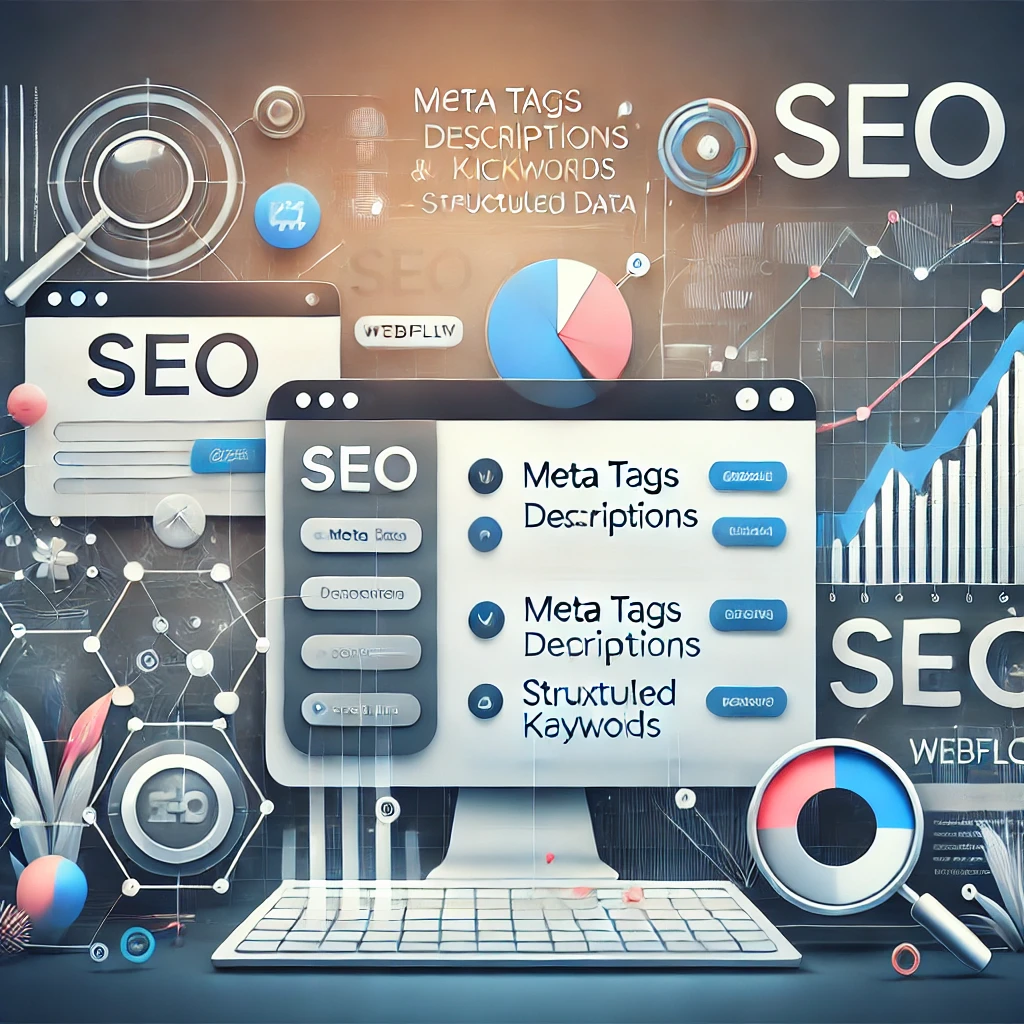1. Introduction to Webflow
Webflow is a powerful web design tool, CMS (Content Management System), and hosting platform all rolled into one. It’s designed to bridge the gap between designers and developers by providing a visual canvas where you can design websites visually while generating clean, semantic code in the background. This unique approach makes Webflow an excellent choice for both beginners and experienced developers looking to streamline their workflow.

2. Why Choose Webflow?
There are several reasons why Webflow has become a go-to platform for many web designers and developers:
- No-Code Development: Webflow allows you to design websites visually, without writing code, making it accessible to non-developers.
- Responsive Design: Webflow automatically creates responsive versions of your website, ensuring it looks great on any device.
- Built-In Hosting: Webflow offers reliable, fast hosting with global CDN, SSL, and custom domain support.
- Custom Interactions: Webflow’s powerful interactions and animations tools let you create engaging, interactive websites.
- CMS Capabilities: With Webflow’s CMS, you can build dynamic content-driven websites, from blogs to portfolios to e-commerce stores.
3. Getting Started with Webflow
Getting started with Webflow is straightforward. Here’s a step-by-step guide:
Sign Up: Begin by signing up for a Webflow account. You can start with a free plan to explore the platform.
Choose a Template or Start from Scratch: Webflow offers a variety of templates to get you started quickly, or you can start with a blank canvas to build something entirely custom.
Explore the Webflow Dashboard: Familiarize yourself with the Webflow interface, which includes the Designer, CMS, and Hosting sections.
Understand the Designer Interface: The Webflow Designer is where you’ll spend most of your time. It’s a visual editor where you can drag and drop elements, style them, and see your website come to life in real-time.
Publish Your First Site: Once you’re happy with your design, you can publish your website directly from Webflow. You can use a Webflow.io subdomain or connect your own custom domain.
4. Key Features of Webflow
Webflow is packed with features that make it a powerful tool for web development:
- Drag-and-Drop Interface: Webflow’s visual editor lets you drag and drop elements to build your site, but it also offers precision control for more advanced users.
- Global Styles and Classes: Create consistent styles across your website by defining global classes for typography, colors, and more.
- Interactions and Animations: Webflow’s interaction tools allow you to create complex animations and interactions without coding.
- Custom Code: While Webflow is a no-code platform, it allows you to add custom code for additional functionality, giving you the best of both worlds.
- CMS and Dynamic Content: Webflow’s CMS lets you create and manage dynamic content like blogs, portfolios, and e-commerce products.
- E-commerce Capabilities: Build and manage an online store with Webflow’s e-commerce tools, complete with product management, shopping cart, and checkout.
5. Building Your First Website
Building your first website with Webflow can be an exciting experience. Here’s how you can approach it:
Plan Your Design: Before diving into Webflow, it’s important to plan your website’s structure, design, and content. Sketch out your ideas, choose a color scheme, and gather the content you’ll need.
Create a Style Guide: Set up a style guide in Webflow to define your global styles, such as fonts, colors, and buttons. This will help maintain consistency across your site.
Start with the Homepage: Begin by designing the homepage, which sets the tone for the rest of your website. Use Webflow’s layout tools to structure your content, add images, and style your text.
Design Inner Pages: Once your homepage is complete, move on to designing the inner pages, such as About, Services, and Contact pages. You can duplicate sections from the homepage to maintain consistency.
Add Interactions: Use Webflow’s interactions panel to add animations and transitions to elements like buttons, images, and text. This will make your website more engaging.
Test Responsiveness: Make sure your website looks great on all devices by using Webflow’s responsive design tools. Adjust the layout for different screen sizes as needed.
Publish and Optimize: Once you’re satisfied with your website, publish it on the Webflow.io domain or connect your custom domain. Don’t forget to optimize your site for SEO to improve its visibility in search engines.
6. Advanced Webflow Techniques
Once you’re comfortable with the basics, you can start exploring more advanced techniques in Webflow:
Custom Interactions: Dive deeper into Webflow’s interaction tools to create complex animations, parallax effects, and scroll-based animations.
Integrating Third-Party Tools: Webflow allows you to integrate with third-party tools like Zapier, Google Analytics, and Mailchimp to extend your website’s functionality.
Custom Code Embeds: If you need to add functionality that’s not available in Webflow, you can use custom code embeds to add HTML, CSS, or JavaScript snippets.
Building a Dynamic CMS: Learn how to leverage Webflow’s CMS to create dynamic content, such as blogs, portfolios, or directories. You can use collections to manage your content and bind it to your design.
Advanced SEO Techniques: Optimize your Webflow site further with advanced SEO techniques, such as setting up 301 redirects, optimizing page speed, and using structured data.
7. Webflow for E-Commerce
Webflow’s e-commerce capabilities make it a strong contender for building online stores. Here’s how to get started with Webflow e-commerce:
Set Up Your Store: Use Webflow’s e-commerce settings to add products, set prices, and configure payment gateways.
Design Your Product Pages: Customize your product pages using Webflow’s visual editor, ensuring they align with your overall brand design.
Configure Shipping and Taxes: Set up shipping rules and taxes according to your business needs. Webflow provides flexible options to manage these settings.
Launch Your Store: Once everything is set up, publish your store and start selling. Webflow’s e-commerce tools include inventory management, order processing, and customer management.
8. Optimizing Your Webflow Site for SEO
SEO is crucial for driving traffic to your website. Webflow provides several tools to help you optimize your site:
Meta Tags and Descriptions: Set custom meta titles, descriptions, and keywords for each page to improve your site’s visibility in search engines.
Clean, Semantic Code: Webflow generates clean, semantic HTML code, which is important for SEO.
Fast Loading Times: Webflow’s hosting is optimized for speed, which is a key ranking factor in search engines.
Mobile Optimization: With Webflow, your site is automatically responsive, which improves its performance in mobile search results.
Schema Markup: Add schema markup to your Webflow site to help search engines understand your content better and improve rich snippets.

9. Webflow vs. Traditional Development
Webflow offers a unique approach to web development compared to traditional methods:
Speed of Development: Webflow allows for rapid prototyping and development, reducing the time to launch a website compared to coding from scratch.
Design Freedom: Webflow gives designers more control over the final product without the need to hand off designs to developers.
Code Quality: Webflow generates clean, semantic code, but it may not be as optimized or customizable as hand-coded solutions.
Learning Curve: Traditional development requires knowledge of HTML, CSS, and JavaScript, whereas Webflow’s visual editor has a shorter learning curve.
Flexibility: While Webflow is powerful, traditional development offers more flexibility and customization options, especially for complex projects.
10. Best Practices for Webflow Development
To make the most of Webflow, consider these best practices:
Consistent Naming Conventions: Use clear and consistent naming conventions for classes and elements to keep your project organized.
Use Symbols: Webflow’s symbols feature allows you to reuse components across your site, making it easier to maintain consistency.
Keep it Simple: Avoid overcomplicating your design with too many interactions or custom code. Focus on creating a clean, user-friendly experience.
Test Regularly: Regularly test your website on different devices and browsers to ensure it works seamlessly for all users.
Optimize Images: Compress images before uploading them to Webflow to improve site speed and performance.
11. Conclusion
Webflow is a game-changer in the world of web development, offering a powerful, flexible platform that combines design freedom with robust development tools. Whether you’re a seasoned developer or just starting, Webflow can help you create beautiful, responsive websites that stand out





